| dc.contributor.author | Mézeth, Kjersti Bringsvor | |
| dc.contributor.author | Patel, Sonal | |
| dc.contributor.author | Henriksen, Håvard | |
| dc.contributor.author | Szilvay, Anne Marie | |
| dc.contributor.author | Nerland, Audun H. | |
| dc.date.accessioned | 2011-11-03T13:09:06Z | |
| dc.date.available | 2014-02-12T00:01:17Z | |
| dc.date.issued | 2009-02-12 | |
| dc.identifier.issn | 0177-5103 | |
| dc.identifier.issn | 1616-1580 | |
| dc.identifier.uri | http://hdl.handle.net/11250/108864 | |
| dc.description.abstract | Betanodavirus infects both larvae and juvenile fish and can cause the disease viral encephalopathy and retinopathy (VER). During an acute outbreak of VER, infected individuals display several clinical signs of infection, i.e. abnormal swimming pattern and loss of appetite. Betanodaviruses can also cause chronic or persistent infection where the infected individuals show no clinical signs of infection. During infection the viral sub-genomic RNA3 and the RNA3-encoded B2 protein are expressed. Antibodies against the B2 protein from Atlantic halibut nodavirus were raised and used together with antibodies against the capsid protein to detect the presence of these 2 viral proteins in infected cells in culture and at different stages of infection in Atlantic halibut Hippoglossus hippoglossus and Atlantic cod Gadus morhua. The B2 protein was detected in recently infected, but not in chronically infected fish. Results suggest that the detection of B2 may be used to discriminate a recent and presumably active infection from a chronic and presumably persistent infection. | no_NO |
| dc.language.iso | eng | no_NO |
| dc.publisher | Inter-Research | no_NO |
| dc.subject | nodavirus | no_NO |
| dc.subject | halibut | no_NO |
| dc.subject | cod | no_NO |
| dc.subject | torsk | |
| dc.subject | kveite | |
| dc.title | B2 protein from betanodavirus is expressed in recently infected but not in chronically infected fish | no_NO |
| dc.type | Journal article | no_NO |
| dc.type | Peer reviewed | no_NO |
| dc.subject.nsi | VDP::Agriculture and fishery disciplines: 900::Fisheries science: 920::Fish health: 923 | no_NO |
| dc.source.pagenumber | 97-103 | no_NO |
| dc.source.volume | 83 | no_NO |
| dc.source.journal | Diseases of Aquatic Organisms | no_NO |
| dc.source.issue | 2 | no_NO |
| dc.identifier.doi | http://dx.doi.org/10.3354/dao02015 | |
